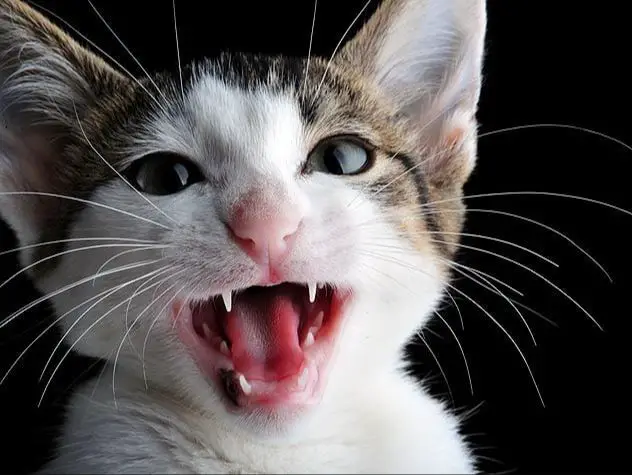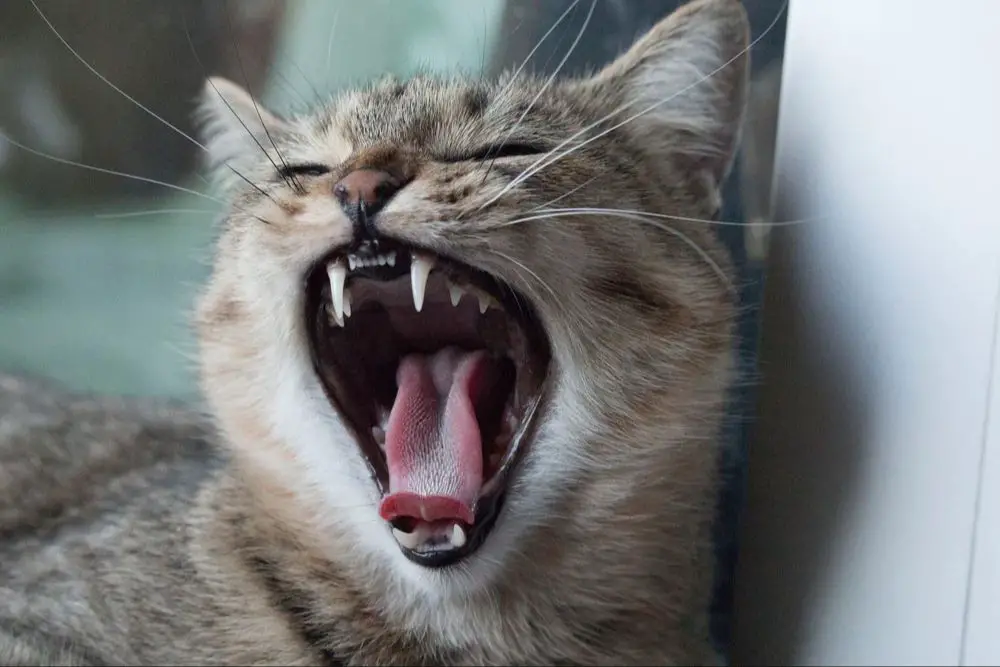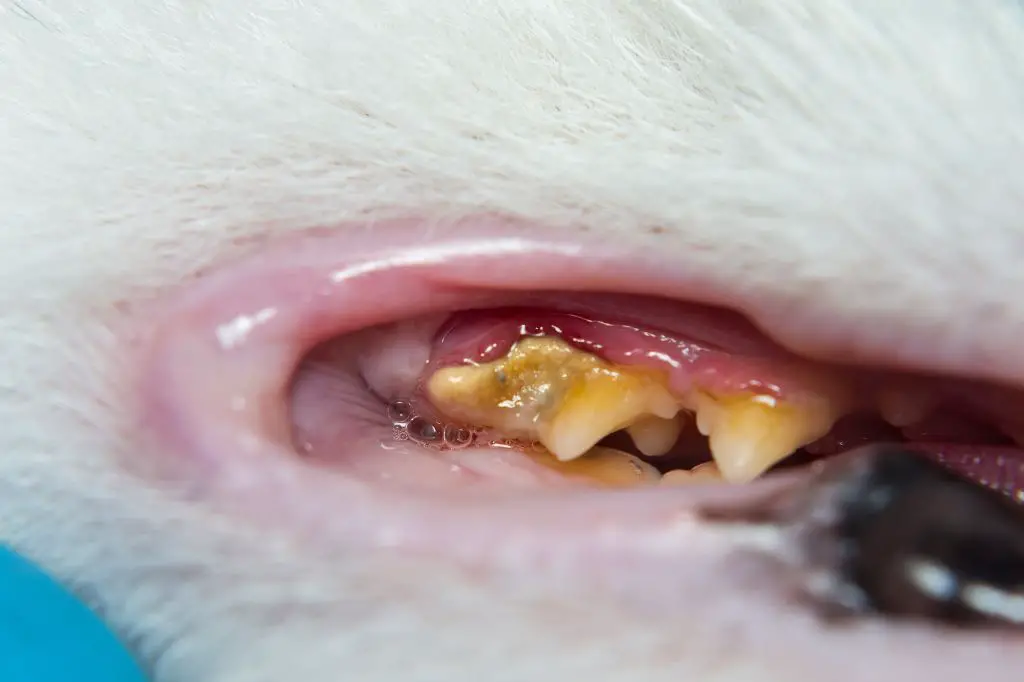Kittens go through a teething process just like human babies. They are born without any teeth, and develop baby teeth starting around 3-4 weeks old. These milk or deciduous teeth eventually fall out as the permanent adult teeth grow in. This article will provide an overview of the teething process in kittens, including the timeline of when milk teeth appear and fall out, tips for caring for teething kittens, and signs of potential dental issues to look out for.
Types of Teeth
Like humans, cats have different types of teeth that serve different purposes. Kittens develop four main types of teeth:
- Incisors – Kittens have a total of 12 small, sharp incisor teeth at the front of the mouth (6 on top and 6 on bottom). Incisors help kittens bite and cut through food.
- Canines – Also known as fangs, canines are the sharp, pointed teeth on either side of the incisors. Kittens have 4 canine teeth total (2 on top and 2 on bottom) that help them tear meat and kill prey.
- Premolars – Premolars are located behind the canine teeth and have a flat surface for grinding food. Kittens have a total of 10 premolars (6 on top and 4 on bottom).
- Molars – Kittens have 4 molars, 2 on the top and 2 on the bottom, located furthest back in the mouth. Molars help crush and grind food.

Knowing the different types of teeth kittens develop helps understand their chewing, biting, and eating capabilities at various stages of development.
Kittens’ Teeth at Birth
Kittens are born completely toothless. They do not have any visible teeth when first born. This is known as the toothless stage and lasts for the first 2-4 weeks of a kitten’s life. During this initial stage, kittens rely on nursing from their mother for nourishment. Without any teeth, newborn kittens can only drink milk and cannot eat solid foods yet.
According to veterinarians, kittens are born toothless for an evolutionary reason. If kittens had teeth at birth, they could potentially hurt their mother while nursing. By being born toothless, kittens can nurse without causing any injury or pain to the mother cat.
The toothless stage for kittens lasts approximately 3-4 weeks. During this initial period, the kittens’ gums and jaws are developing in preparation for the teeth to eventually erupt through. Even without teeth, kittens have a strong need to suckle during these early weeks of life which satisfies nutritional needs and promotes bonding with the mother.
Appearance of Milk Teeth
Kittens’ milk teeth start appearing around 2-4 weeks of age. The first teeth to erupt are the middle incisors in the upper and lower jaws, usually appearing between 14-21 days old. Next, the lateral incisors adjacent to the middle incisors come in within a week or two. By around 4-6 weeks of age, the canines and premolars emerge to fill out the kitten’s mouth. Kittens have a complete set of 26 deciduous or “milk” teeth by about 6-8 weeks old [1].
The order and timeline that kittens’ milk teeth come in is as follows:
- 14-21 days: Middle incisors (6 total)
- 21-35 days: Lateral incisors (6 total)
- 28-42 days: Canines (4 total)
- 35-49 days: Premolars (10 total)
This predictable sequence allows the milk teeth to emerge alongside the kitten’s developing bite and jaw musculature for proper chewing and eating. The small, razor-sharp milk teeth aid the kitten in grasping food and provide a placeholder for the larger permanent teeth to come later.
Losing Milk Teeth
Kittens start losing their milk teeth and transitioning to permanent teeth around 3-4 months of age. The process starts with the incisors (the small front teeth) and progresses to the canines, premolars, and finally the molars.
The milk teeth become loose and fall out as the permanent adult teeth push up from below. Kittens may swallow some of their falling milk teeth, which is normal. You may find some milk teeth on the floor or in their bedding as they get pushed out.
Kittens should have lost all their milk teeth except the canines by around 6 months old. The canine milk teeth are the last to fall out, usually between 5-7 months of age. By 6-7 months old, kittens should have a full set of 30 adult teeth.

Signs that a kitten is losing milk teeth and teething include: drooling, reluctance to eat hard food, decreased appetite, chewing on non-food items, swollen gums, loose teeth. Some kittens may be fussier during teething. Gentle gum massage and soft foods can help soothe their discomfort.
It’s important not to pull out milk teeth prematurely. Allow them to come out on their own to avoid damaging permanent teeth developing below. If a milk tooth hasn’t fallen out by 7 months, it’s best to get it extracted by a vet.
Permanent Teeth
Cats have 30 permanent adult teeth that start coming in around 3-4 months of age to replace their milk teeth (deciduous teeth) (VCA Hospitals). The permanent teeth consist of 16 premolars and molars (the back grinding teeth) and 14 incisors and canines (the front biting teeth).
The permanent teeth are larger and stronger than the milk teeth. They have thicker enamel and longer roots that extend deep into the jawbone for stability. The permanent teeth help cats chew and slice their food properly as adults.
The full set of adult teeth is usually finished erupting around 6-7 months of age. However, the upper fourth premolars may not erupt until about 9 months (Merck Veterinary Manual). This gradual process allows the permanent teeth to grow in properly aligned and spaced.

If any milk teeth are not shed and remain in place, this can prevent the permanent teeth from erupting correctly. Retained milk teeth should be extracted by a veterinarian to allow the permanent teeth to erupt properly.
Caring for Kittens’ Teeth
Proper dental care for kittens is extremely important as their adult teeth grow in. Here are some tips for caring for your kitten’s teeth:
- Start brushing your kitten’s teeth daily as soon as you bring them home. Use a soft-bristled brush and pet-safe toothpaste.
- Get your kitten used to having their mouth handled and teeth brushed from a young age so they accept it more easily as an adult.
- Use dental treats and chews formulated for kittens to help remove plaque and tartar as their teeth emerge.
- Choose veterinary dental food or additives that support your kitten’s oral health.
- Take your kitten to the vet for regular dental checkups to monitor for any potential problems.
- Schedule a professional teeth cleaning with your vet once your kitten is around 6-12 months old when their adult teeth have fully emerged.
- Watch for signs of dental disease like bad breath, difficulty eating, or excess drooling and take your kitten to the vet promptly if you notice any issues.
Establishing excellent at-home dental care and bringing your kitten to the vet will help set up healthy teeth and gums for life. Investing in your kitten’s dental health early on can prevent painful and expensive problems down the road.
Teething Issues
Kittens can experience some discomfort and issues while they are teething. As their baby teeth erupt and their adult teeth develop under the gums, the pressure on their gums can cause pain and irritation. Some common teething issues in kittens include:
Chewing and biting – Kittens may chew on toys, furniture, hands and feet more often. The pressure on their sore gums provides some relief. Provide safe chew toys to redirect this behavior.
Decreased appetite – Teething kittens may eat less due to mouth pain. Offer soft foods that are easier to chew and swallow.
Irritability – Discomfort from teething can make kittens fussy and irritable. Be patient and provide soothing affection during this phase.
Drooling – Excessive drooling is common as teething stimulates more saliva production. Gently wipe their mouth as needed.
Bleeding gums – Some minor gum bleeding can occur as new teeth cut through. This is normal but signs of advanced gum disease should be examined by a vet.
Pawing at their face – Kittens may rub and scratch their face trying to relieve gum pain. Keep their nails trimmed to prevent self-injury.
Providing kittens with chew toys, soft foods, patience and veterinary monitoring can help them through the teething process with minimal issues. Most discomfort is temporary and subsides once all adult teeth have erupted.1 2
Signs of Dental Problems
There are several warning signs that may indicate a kitten is suffering from dental disease. According to the Cornell Feline Health Center, signs to look out for include1:

- Bad breath
- Bleeding from the mouth
- Difficulty or reluctance to eat
- Excessive drooling
- Loose or broken teeth
- Red, inflamed gums
- Swollen or abscessed gums
- Tumors in the oral cavity
Kittens may also paw at their mouth, shake their head, or chew only on one side if they have dental pain. You may notice sneezing or nasal discharge if advanced dental disease is present2. Any signs of dental problems in a kitten warrant a veterinary checkup to diagnose and treat the underlying issue.
Conclusion
Kittens go through a fascinating process of losing their milk teeth and growing in permanent adult teeth. Keeping an eye on this developmental stage is crucial to ensure your kitten’s teeth come in properly. Any issues should be addressed right away by your veterinarian.
While the teething process may cause some temporary discomfort, overall it is an important milestone in a kitten’s maturation. Proper dental care from a young age lays the foundation for lifelong health. Make sure to brush your kitten’s teeth daily, provide appropriate chew toys, and feed a balanced diet. Schedule regular vet checkups to monitor for any potential problems.
With attentive care and monitoring, your kitten’s baby teeth should give way to a strong set of permanent teeth, allowing them to comfortably eat, play, and thrive through adulthood. Keeping up with your kitten’s dental development is one key way pet parents can support the health and wellbeing of their feline friends.

